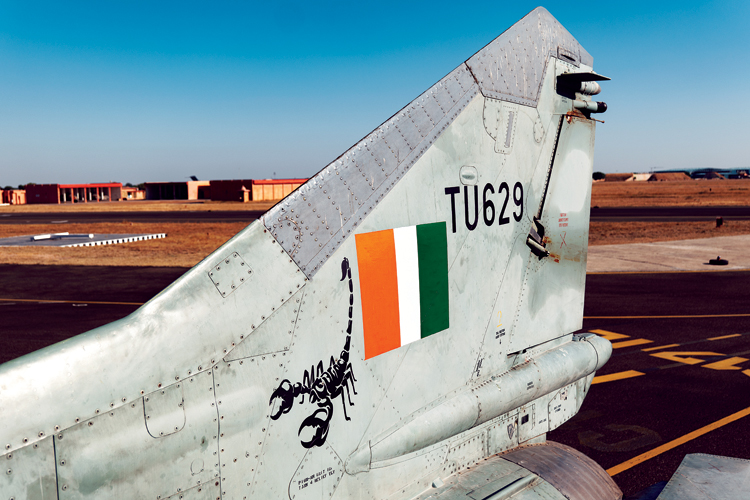INDIAN ARMED FORCES CHIEFS ON
OUR RELENTLESS AND FOCUSED PUBLISHING EFFORTS

SP Guide Publications puts forth a well compiled articulation of issues, pursuits and accomplishments of the Indian Army, over the years

I am confident that SP Guide Publications would continue to inform, inspire and influence.

My compliments to SP Guide Publications for informative and credible reportage on contemporary aerospace issues over the past six decades.
MiG-27 Fleet of the IAF Retired from Service
NEWS:
On Friday, December 27, 2019, the Indian Air Force (IAF) retired from service the last of its MiG-27 jets at a ceremony at Air Force Station, Jodhpur. With the IAF retiring its MiG-27 fleet 35 years after it was inducted into service, the Kazakhstan Air Force will now be the only one in the world that will be operating this aircraft. “The fleet of MiG-27 aircraft of the IAF has made immense contribution to national security, both during peace and war. The fleet earned its glory in the historic conflict with Pakistan in Kargil in the year 1999 when it delivered rockets and bombs with accuracy on enemy positions,” said a statement released by the Ministry of Defence on Thursday, December 26, 2019.

VIEWS:
As against 42 combat squadrons authorised by the government for a two-front war contingency, the IAF is left with just 30, the lowest strength in decades. Of these, the Su-30 MKI fleet, the only fourth-generation platform the IAF has, will constitute 15 squadrons once all of the 272 aircraft on order are delivered by Hindustan Aeronautics Limited (HAL). Another 12 aircraft are being ordered taking the strength of squadrons to 16. The rest of the combat fleet consists of platforms such as unmodified MiG-21, MiG-21 Bison, MiG-29, Jaguar and Mirage 2000, all of third-generation vintage fast approaching obsolescence.
Bidding farewell to the last squadron of MiG-27 that are obsolete, will reduce the strength of the combat fleet marginally, but in reality, it will not make any significant dent in the already degraded operational capability of the IAF. However, phasing out of the MiG-27 fleet ought to serve as a reminder of the worrisome state the combat fleet of the IAF is in. The IAF needs to find ways to upgrade its operational capability as quickly as possible with new generation combat aircraft.
It is not that the IAF is not aware of the state of its combat fleet and the need to take urgent steps to restore its operational edge over its traditional adversaries. The IAF initiated a programme as early as in the year 2002 to procure 126 medium multi role combat aircraft (MMRCA) and after an elaborate process of evaluation of products offered by six global aerospace majors, the Rafale fighter jet from Dassault Aviation of France was identified as the preferred platform. Unfortunately, the process of acquisition of this fourth-generation platform encountered insurmountable impediments on account of which, the exercise to procure the fleet of 126 Rafale jets was finally cancelled in 2015. In response to a request by the IAF, the government led by Prime Minister Modi, arranged direct purchase of 36 Rafale jets through a government-to-government deal with France. To be delivered by 2022, this lot of 36 Rafale combat jets will equip two squadrons and provide some respite for the IAF in respect of its dwindling fleet of combat jets. But the vigorous and ugly politically driven slugfest over this deal as also efforts by some vested interests to have the deal scuttled through intervention by the highest court in the country, has indeed been a matter of concern for the IAF. Fortunately, these efforts to sabotage the deal have not succeeded so far, but the IAF is keeping its fingers crossed! Meanwhile, in lieu of the aborted MMRCA tender, the IAF initiated a case for the procurement of 114 multi-role fighter aircraft bulk of which is to be manufactured in India following the Strategic Partnership model. Response from seven global aerospace majors to the RFI was received in July 2018. Unfortunately, the tender is yet to be issued and as to when it will be, is shrouded in uncertainty.
In the decade beginning January 2020, the combat fleet of the IAF will continue to dwindle further. The unmodified MiG-21 fleet will be retired from service by March 2020. This will be followed by the retirement in the early part of the decade of the six squadrons of the Jaguar fleet as plans to re-engine this platform with new and more powerful engines from Honeywell, have been abandoned by the government on account of exorbitant cost and hence the life of the fleet cannot be extended. The MiG-21 Bison fleet will continue till 2021.
The three squadrons of MiG-29 air defence fighters are being upgraded and the fleet size is being enhanced through purchase of 21 of these platforms offered by Russia. But the most obvious solution to the problem of the combat fleet is to enhance production of the light combat aircraft (LCA) Tejas Mk I and IA of which a total of 123 have been ordered so far. Unfortunately, the performance of the Indian aerospace industry in respect of development and manufacture of the LCA has not been very inspiring. However, the IAF is still banking on HAL to provide 83 LCA Mk IA in addition to 40 Mk I to replace the retiring MiG-21 and MiG-27 fighters. The government certainly needs to focus on enhancing the production capability of HAL to enhance self reliance. But perhaps the most serious impediment for the IAF in its effort to revamp its combat fleet is inadequate funding which is evident in the shortfall of 53,035 crore in the budgetary allocation for the financial year 2019-20. Hopefully, this will be corrected in the next financial year failing which, the IAF will continue to be in grief.





